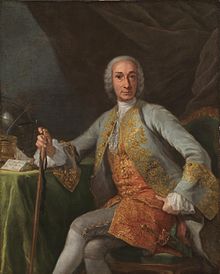Leopoldo de Gregorio
Leopoldo de Gregorio , Margrave of Squillace (Italian: Marchese di Squillace; Spanish: Marqués de Esquilache) (* around 1700 in Messina , Sicily ; † September 15, 1785 in Venice ), was a Sicilian civil servant and politician in the service of Spain .
Life
Early years
Gregorio was of low origin. Little is known of his youth and training. He worked as an accountant for the Barretta trading house until 1742 and then moved to the service of the Neapolitan army. Under the Bourbon King Charles III. , the son of King Philip V of Spain , he served as quartermaster for the army in the War of the Austrian Succession .
Minister in Naples
In 1746 King Charles appointed him head of the Neapolitan customs administration and in 1748 as finance minister of his kingdom. Under the chairmanship of the enlightener Bernardo Tanucci , Gregorio was one of the energetic members of the closest circle of advisors who implemented Charles's reform efforts in the state administration. Thus Naples achieved a taxation of church property and the disempowerment of the aristocratic landowners, who until then had played the leading role in the politics of the kingdom.
In 1755 the king elevated Gregorio to the rank of margrave of Squillace; under the Spanish variant of this title, Marqués de Esquilache , he achieved fame.
Minister in Spain
When Karl inherited the Spanish throne in 1759, part of his advisory staff, including Tanucci, stayed in Naples to ensure the continuation of the reform policy under Charles' son, Ferdinand . The Margrave Esquilache followed Karl to Madrid. He also took over the Ministry of Finance from Francisco Ruiz de Gaona , Count of Valdeparaíso. He married a Spanish woman, María Verdugo.
After the resignation of Ricardo Wall , he briefly took over the Ministry of War. Together with Zenón de Somodevilla y Bengoechea , Marqués de Ensenada , he began to reform the Spanish tax system and also to tax the nobility, the clergy and the knightly orders. Esquilache had great influence on the monarch, even if he was formally under Prime Minister Jerónimo Grimaldi . Esquilache was assertive and ruthless in pursuing his political line. Diplomatic skills were not one of his strengths. In the spirit of enlightened absolutism, he wanted to modernize Spain (like Sicily and Naples before). He restricted the power of the clergy, banned public gambling and the carrying of firearms.
In the course of these modernizations, he also wanted to adapt the appearance of Madrid to the spirit of the times. On the one hand, this happened through a number of new buildings and urban development developments that Karl III. toasted. On the other hand, the clothing of the Madrid men was a thorn in his side. Esquilache forbade the wearing of the traditional wide-brimmed hat ( sombrero ) and long coats. Instead, according to the French-influenced fashion of the time, the Madrid people should wear short coats and tricorns.
In contrast, the population revolted in March 1766, which went down in history as the “ Madrid Hat Rising ” (Spanish; Motín de Esquilache , literally: Esquilache Rising ). The king had to flee temporarily to Aranjuez , the house of Prime Minister Grimaldi was devastated. Only through the mediation of church representatives (ironically, it was Jesuits of all people) could the people calm down. Esquilache was released as a concession to the insurgents and fled to Naples.
Late years
From Naples, Esquilache struggled to be rehabilitated at court and to get back to office. It was not until 1772 that the pressure was given in and he was sent to Venice as the Spanish ambassador . He died there in 1785.
Web links
- Artehistoria: biography (spanish)
| predecessor | Office | successor |
|---|---|---|
| Prince Montealegre |
Spanish envoy in Venice 1772 to 1785 |
Francisco Salinas Moñino |
| personal data | |
|---|---|
| SURNAME | De Gregorio, Leopoldo |
| ALTERNATIVE NAMES | Margrave of Squillace; Marquis de Esquilache; Marqués de Esquilache; Marchese di Squillace |
| BRIEF DESCRIPTION | Sicilian civil servant and politician in the service of Spain |
| DATE OF BIRTH | around 1700 |
| PLACE OF BIRTH | Messina , Sicily |
| DATE OF DEATH | September 15, 1785 |
| Place of death | Venice , Italy |
